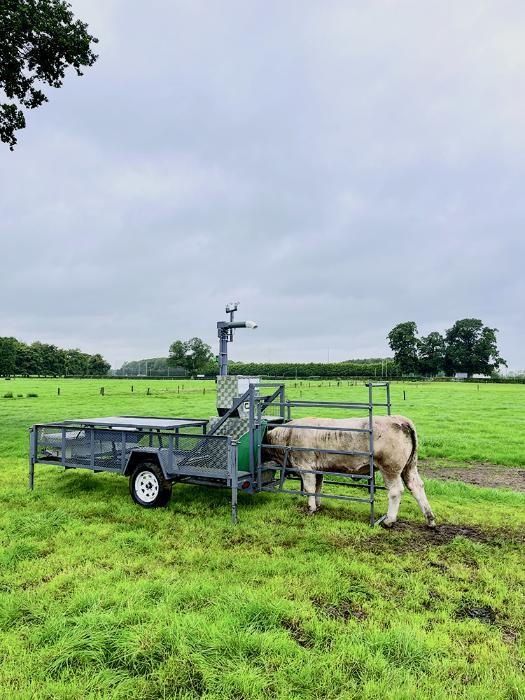27 November 2023
Measure for measure
An important focus for methane mitigation efforts is to develop strategies to accurately measure and reduce methane emissions in grazing dairy, beef and sheep, explain AGRIC Principal Research Officer Sinead Waters, Walsh Scholar Emily Roskam, and Research Officer Ben Lahart.
An important focus for methane mitigation efforts is to develop strategies to accurately measure and reduce methane emissions in grazing dairy, beef and sheep, explain AGRIC Principal Research Officer Sinead Waters, Walsh Scholar Emily Roskam, and Research Officer Ben Lahart.
The agricultural industry is facing a major challenge, with a legally binding 25% reduction of agricultural greenhouse gases (GHGs) required by 2030. Methane, one of the most potent GHGs, is derived from feed digestion in the stomach of livestock and from manure storage. As of 2021, methane accounts for ~68% of agricultural GHG emissions.
Teagasc’s research programme on methane emissions is focused on:
- developing and refining country-specific emission factors
- mitigation strategies associated with reducing the age of finishing, feed quality,
- genetics and feed additives
- manure treatment and additives.
Through collaborative efforts between Teagasc, ICBF, DAFM, VistaMilk and MTI, GreenFeed technology and Portable Accumulation Chambers have been deployed to study bovines (dairy cows and beef cattle) and sheep, respectively. This has enabled widespread quantification of methane emissions, which is being used to refine the national inventories. Through this work, a seasonal nature to methane output from grazing dairy cows has been demonstrated, with the lowest methane output observed in the spring period. This has equated to ~9% less methane being lost as a proportion of gross energy intake, compared to the value used in the national inventory.
Data-driven indexing
Breeding programmes offer long-lasting and cumulative solutions for producing more efficient ruminants. Research has demonstrated that high genetic merit dairy cows selected for the Economic Breeding Index produce more milk solids, without an associated increase in methane output and reduced overall methane intensity (methane per unit of milk solids). Direct selection for low methane-emitting animals is also possible within breeding indexes.
Through the EU MASTER and DAFM-funded GREENBREED projects in collaboration with ICBF, methane and performance data were collected, creating a final dataset of 1,600 beef cattle. Animals were ranked as low, medium or high emitters. Beef cattle ranked as ‘low’ produced 30% less methane but maintained the same level of animal performance (feed intake, growth rate, carcass output) as their ‘high’-emitting counterparts. Data obtained has contributed to the development of the world’s first genetic methane evaluations for beef cattle published by the ICBF, which will need to be validated in future studies in grazing systems. Research is also ongoing regarding differing grazing management practices and the incorporation of different plant species, such as clover in grazing swards on methane emissions. Sheep given perennial ryegrass swards including clover (white or red), rank lower for methane output. Regarding feed additives, a series of indoor beef studies have been conducted with promising results (% methane reduction) obtained from feeding linseed oil (-18%), rapeseed oil (-9%) and a seaweed extract (-7%) in a twice-daily feeding regimen.
Reducing methane emissions
Bovaer, a feed supplement, was assessed through a total mixed ration, resulting in beef cattle emitting 30% less methane. Supplementation of Bovaer to dairy cattle within indoor settings has demonstrated similar results (-26%). However, at pasture, a transient effect was demonstrated, resulting in a ~-6% reduction in methane. The most promising additive to date in beef cattle is the supplementation of calcium peroxide, in a pellet (resistant to pressure and temperature), offered twice a day, yielding a reduction of 28% with no effects on feed intake or animal productivity.
A number of promising manure additives have been identified that reduce both methane and ammonia losses from manure storage and housing. These additives can reduce emissions by over 70% and increase the biogas yield potential of manure used as a feedstock of anaerobic digestion. Manure management technologies require further investigation to identify solutions that are practical on-farm for reducing emissions. Future work will focus on generating methane production data from ruminants of all ages and across a range of dietary regimes to help validate breeding values for dairy, beef and sheep, as well as further refining the national GHG inventories for methane.
As further research is required to develop long lasting and sustainable feed additives for beef and dairy grazing systems, a major focus is the reformulation of promising feed additives into slow release formats that can be incorporated into once-daily concentrate supplementation or a rumen bolus for long-lasting mitigation effects during grazing.

Ruminants at pasture at Teagasc Grange are able to have their methane measured through the GreenFeed system
[pic credit] Teagasc
